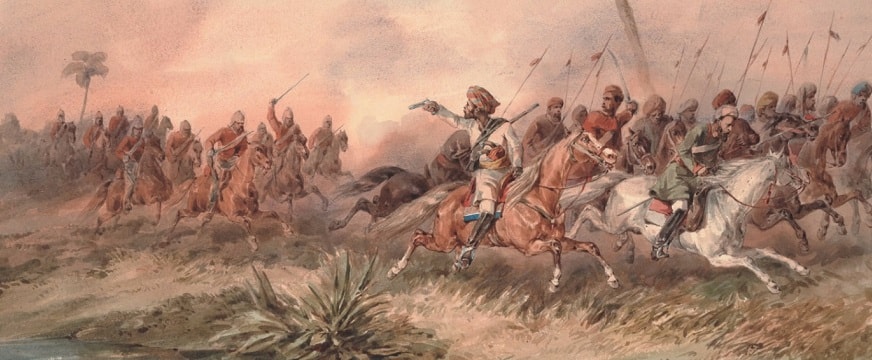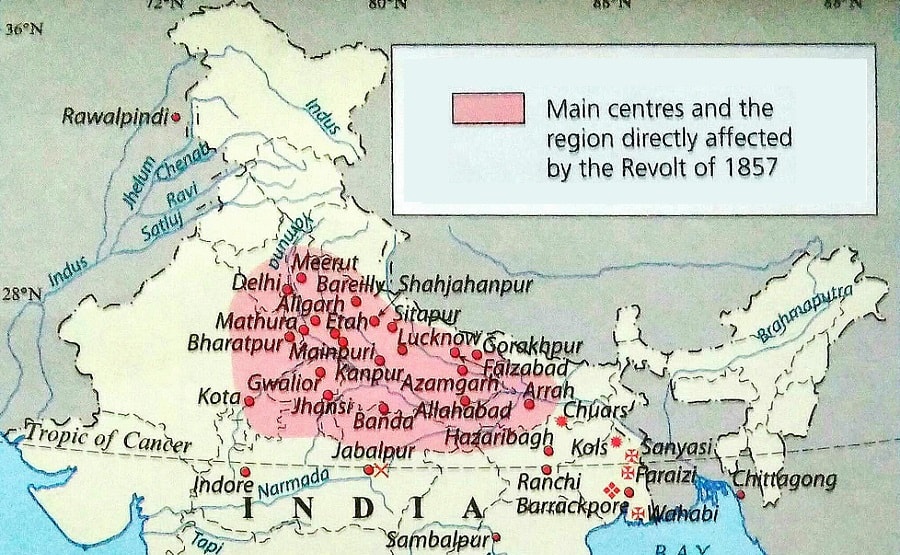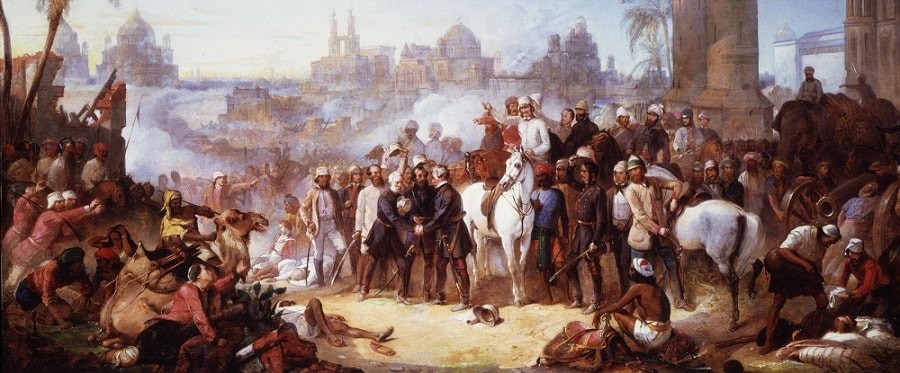Revolt of 1857 in India – Sepoy Mutiny
Contents
>>>>>
Major Causes of Revolt of 1857
Economic Causes
- Colonial policies destroyed the traditional economy of Indian society.
- High land revenue disabled peasantry class.
- Money-lenders and traders emerged as the new landlords.
- Heavy Taxation on artisans and handicrafts.
- Annexation of Indian states by the Company cut off their major source of patronage.
- Discriminatory tariff policy against Indian made products.
- Free Trade and refusal to impose protective duties against machine-made goods from Britain simply killed Indian manufacture.
- Ruin of Indian industry increased the pressure on agriculture and land.
- Zamindars, lost their lands and status in villages.
- In Awadh, storm centre of the revolt of 1857, 21,000 taluqdars suddenly found themselves without a source of income.
>>>>

>>>>>>>>
Political Causes
- British expansionist policies, most of Raja’s, Nawab’s and zamindar’s, were either dispossessed or became subsidiary to the British.
- Subsidiary alliance and Doctrine of Lapse policy hampered the interests of the rulers of the native states.
- They one by one became victims of British expansionism.
- British abolished many rulers title and pensions.
>>>>>
Administrative Causes
- Huge corruption in the Company’s administration, especially among the police, officials and lower law courts, was a major cause.
- Indian judges were not allowed to try criminal cases of Europeans.
- So discrimination was at all levels.
>>>>>
Socio-Religious Causes
- Racial discrimination and superiority complex characterized British attitude towards the native Indian population.
- British attempts at socio-religious reform such as abolition of sati, support to widow-remarriage and women’s education were not acceptable to conservative sections.
- Government’s decision to tax mosque and temple lands and making laws such as the Religious Disabilities Act, 1856.
- Activities of Christian missionaries.
>>>>>
Influence of Outside Events
- Revolt of 1857 coincided with certain outside events in which British suffered serious losses – 1st Afghan War, Punjab Wars and the Crimean Wars (1853-56).
- British were seen to be not so strong and it was felt that they could be defeated.
>>>>>

>>>>>
Discontent Among Sepoys
- Conflict between conditions of service and religious beliefs of sepoys
- Restrictions on wearing caste and sectarian marks.
- 1856, Lord Canning passed General Service Enlistment Act.
- As per the Act recruits of Bengal Army have to give an undertaking to serve anywhere required by the government.
- Hindu of the time, crossing the seas meant loss of caste.
- Foreign service allowance (bhatta) when serving in Sindh or in Punjab was stopped.
- Annexation of Awadh, home of many of the sepoys, further inflamed their feelings.
- Indian sepoy was made to feel a subordinate.
- They was discriminated against racially and in matters of promotion and privileges.
- Sepoy, in fact, was a ‘peasant in uniform’, so torchers over peasants make them more unhappy.
>>>>>
revolt of 1857 in india causes leaders sepoy mutiny indian rebellion
Beginning & Spread of the Revolt
Immediate Cause
- Reports about mixing of bone dust in atta (flour) and introduction of Enfield rifle influece the sentiment of sepoyes.
- Greased wrapping paper of the cartridge of the new rifle had to be bitten off before loading and grease was reportedly made of beef and pig fat.
>>>>>
Beginning of Sepoy Mutiny
- Mutiny started by Mangal Pandey, 34th Native Infantry on 29th March, 1857 at Barrackpur.
- Ninety men of 3rd Native Cavalry at Meerut, refused to accept greased cartridges.
- Eighty-five of them were sentenced to 10 years’ imprisonment.
- Sepoy mutiny began at Meerut, on 10th May, 1857.
- On May 10, they released their imprisoned comrades, killed their officers and unfurled the banner of revolt.
- Then, gathering force rapidly, soon embraced a vast area from the Punjab in north and Narmada in south, Bihar in east and Rajputana in the west.
>>>>>
Choice of Bahadur Shah as Symbolic Head
- Long reign of Mughal dynasty had become traditional symbol of India’s political unity.
- So, Delhi was soon to become centre of Great Revolt and Bahadur Shah, its symbol.
- Aged and powerless Bahadur Shah Zafar was proclaimed the Emperor of India.
- Outlook of rebels was not influenced by religious identity.
- They took British as the common enemy.
- Entire Bengal Army soon rose in revolt which spread quickly.
- Awadh, Rohilkhand, Doab, Bundelkhand, central India, large parts of Bihar and East Punjab shook off British authority.
>>>>>
Civilians Join
- Sepoy mutiny was accompanied by a rebellion of civil population particularly in north-western provinces and Awadh.
- Peasants and petty zamindars took advantage of revolt to destroy money-lenders’ account books and debt records.
>>>>>>
revolt of 1857 in india causes leaders sepoy mutiny indian rebellion
Storm Centers & Leaders of Revolt
| Center | Leader | British | Remakes |
|---|---|---|---|
| Delhi | Bakht Khan | John Nicholson Hudson | |
| Kanpur | Nana Saheb Tantia Tope | Hugh Wheeler Havelock Colin Campbell | Hugh Wheeler surrendered and killed |
| Lucknow | Begum Hazrat Mahal | Henry Lawrence James Neill Havelock Colin Campbell | Death of Lawrence, Neill, Havelock |
| Jhansi | Rani Laxmibai | Hugh Rose | Tantia Tope joined Laxmibai after loss of Kanpur |
| Bareilly | Khan Bahadur | Colin Campbell | |
| Arrah, Bihar | Kunwar Singh Amar Singh | William Taylor Vincent Eyre | |
| Faizabad, UP | Maulvi Ahmadullah | ||
| Baghpat, UP | Shah Mal |
>>>>>
revolt of 1857 in india causes leaders sepoy mutiny indian rebellion
Reason of Failure
All India participation was Absent
- Limited territorial spread was one factor.
- Revolt of 1857 speeded over only Eastern Punjab, Uttar Pradesh, Bihar and Madhya Pradesh.
>>>>>
All Classes did not Join
- Big zamindars acted as “break-waters to storm”.
- Even Awadh taluqdars backed off once promises of land restitution were made.
- Money-lenders and merchants were not part of revolt of 1857.
- Educated Indians viewed this revolt of 1857 as backward looking, supportive of the feudal order.
- Most Indian rulers refused to join, and often gave active help to the British.
- Sindhia of Gwalior, Holkar of Indore, Gulab Singh of Kashmir, rulers of Patiala, Raja of Jodhpur, Jung Bahadur of Nepal, Rulers of Rajputana and Sikh chieftains.
>>>>>
Poor Arms and Equipment
- Indian soldiers were poorly equipped materially
- They fighting generally with swords and spears and very few guns and muskets
>>>>>
Uncoordinated and Poorly Organised
- Revolt of 1857 was poorly organised with no coordination or central leadership
- Indian rebel leaders were no match to their British opponents in generalship
>>>>>
No Unified Ideology
- Mutineers lacked a clear understanding of colonial rule
- They had no forward looking programme or political perspective or a societal alternative
- Different places leaders were fighting for different cause
>>>>>

revolt of 1857 in india causes leaders sepoy mutiny indian rebellion
Hindu-Muslim Unity Factor
- During the entire revolt, there was complete cooperation between Hindus and Muslims at all levels – people, soldiers, leaders
- According to Maulana Azad, two facts stand out clearly in the midst of the tangled story of the Rising of 1857.
- The remarkable sense of unity among Hindus and Muslims of India in this period.
- The deep loyalty which the people felt for the Mughal Crown.
- Thus, the events of 1857 demonstrated that the people and politics of India were not basically communal or sectarian before 1858.
>>>>>
revolt of 1857 in india causes leaders sepoy mutiny indian rebellion
Nature of the Revolt of 1857
- ‘Sepoy Mutiny’ to some British historians—“a wholly unpatriotic and selfish Sepoy Mutiny with no native leadership and no popular support”, said Sir John Seeley.
- A “planned war of national independence”, by V.D. Savarkar in his book, The Indian War of Independence, 1857. Savarkar called the revolt of 1857 the first war of Indian independence.
- Dr S.N. Sen in his Eighteen Fifty- Seven considers the revolt as having begun as a fight for religion but ending as a war of independence
- Dr R.C. Majumdar, however, considers it as neither the first, nor national, nor a war of independence as large parts of the country remained unaffected
- According to some Marxist historians, the 1857 revolt was “the struggle of the soldier-peasant democratic combine against foreign as well as feudal bondage”.
- Jawaharlal Nehru considered the Revolt of 1857 as essentially a feudal uprising though there were some nationalistic elements in it (Discovery of India).
- M.N. Roy felt the Revolt was a last ditch stand of feudalism against commercial capitalism.
- It had seeds of nationalism and anti-imperialism but the concept of common nationality and nationhood was not inherent to the revolt of 1857
>>>>>
revolt of 1857 in india causes leaders sepoy mutiny indian rebellion
Consequences & Effects
Political Effects
- It led to far reaching changes in the system of administration and the policies of British government.
- 2nd Aug, 1858, British Parliament passed an Act for the Better Government of India.
- The Act declared Queen Victoria as the sovereign of British India.
- This is known as queen’s proclamation.
- Queen’s proclamation was read out by Lord Canning at a durbar held on 1st Nov, 1858 at Allahabad.
- The proclamation put an end to the rule of East India Company.
- Board of Control was abolished.
- A new ministry was created known as ‘India House’, headed by the Secretary of State for India who was a minister of cabinet rank.
- Governor-General became more pronounced and his profile was now counted as the Viceroy representative of the Queen.
- Policy of annexation and expansion of British empire in India ended.
>>>>>
Economic Effects
- Revolt also brought massive economic destruction.
- The public debt of the country rose by about 98 million sterling.
- British now started economic expansion and exploitation in India.
>>>>>
>>>>>
Military Effects
- Army Amalgamation Scheme, 1861 moved Company’s European troops to services of the Crown.
- Number of european troops was increased and all artillery units were placed in European hands.
- The different classes of sepoys were mixed.
>>>>>
Administrative Effects
- Proclamation also promised equal and impartial protection under law to all Indians and equal opportunities in government services
- Indian Civil Service Act of 1861 was passed, which was to give an impression that under Queen all were equal.
- Policies were made to protect landlords and zamindars and give them security of rights over their lands.
- The complete structure of the Indian government was remodeled and based on the notion of a master race – justifying the philosophy of the ‘Whiteman’s burden’.
>>>>>
Social Effects
- British followed the policy of communal disharmony.
- They take policy of non-interference in traditional structure of Indian society and use it against the educated middle class.
>>>>>
Significance of the Revolt
- It brought out in the open grievances of people and the sepoys, which were seen to be genuine.
- Revolt of 1857 did establish local traditions of resistance to British rule.
- It of helped in the course of the national struggle for freedom.
revolt of 1857 in india causes leaders sepoy mutiny indian rebellion



